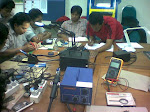The new Scott Genius is a big deal for riders in the United States. Due to Specialized's U.S. patent on the FSR, the previous generation Genius could not be sold in the States, leaving Scott out of arguably the most crucial category - Acordingly, part of the redesign mandate was to make the new Genius "U.S. approved" and no longer blocked by the FSR patent. While the whole bike is new top to bottom, the most significant change was relocating the rear pivot from the chainstay up to the seatstay.

In its introductory presentation, Scott said the company set out to build "The lightest marathon/trail bike with 150mm [5.9 inches] of travel." The frame is a good start - it's all carbon, right down to the dropouts; the derailleur hanger is alloy and replaceable, but mounts to a carbon dropout. Size medium only weighs 4.96 pounds, WITH shock. Scott manufactured the front end by wrapping carbon over mandrels, then cooking it in a mold. The process for removing the mandrels from the fully formed front triangle after molding is, according to the company, an "I-could-tell-you-but-I'd-have-to-kill-you" secret.
The seat-tube pivot, called IAP (Integrated Axial Pivot), is actually comprised of two stub axles molded into the carbon; no sleeve connects the sides together. Not only does this save weight, it also allows the seat post to drop all the way into the frame.
The Genius uses a Shimano direct mount front derailleur and it's a good example of the advantage of the DMD design. There's a lot going on in the Genius's BB area and trying to fit a place for a clamp-on derailleur in there would be an incredible challenge. Scott actually mounts the front derailleur to the chainstay, so it moves with the chainstay as the suspension compresses, eliminating any potential FD/stay interference issues that can plague longer travel bikes.

In its introductory presentation, Scott said the company set out to build "The lightest marathon/trail bike with 150mm [5.9 inches] of travel." The frame is a good start - it's all carbon, right down to the dropouts; the derailleur hanger is alloy and replaceable, but mounts to a carbon dropout. Size medium only weighs 4.96 pounds, WITH shock. Scott manufactured the front end by wrapping carbon over mandrels, then cooking it in a mold. The process for removing the mandrels from the fully formed front triangle after molding is, according to the company, an "I-could-tell-you-but-I'd-have-to-kill-you" secret.
The seat-tube pivot, called IAP (Integrated Axial Pivot), is actually comprised of two stub axles molded into the carbon; no sleeve connects the sides together. Not only does this save weight, it also allows the seat post to drop all the way into the frame.
The Genius uses a Shimano direct mount front derailleur and it's a good example of the advantage of the DMD design. There's a lot going on in the Genius's BB area and trying to fit a place for a clamp-on derailleur in there would be an incredible challenge. Scott actually mounts the front derailleur to the chainstay, so it moves with the chainstay as the suspension compresses, eliminating any potential FD/stay interference issues that can plague longer travel bikes.








1 comment:
Hi apa Khabar,
Saya perlu nasihat saudara.
Nama saya Venu dari Malaysia.
Saya ingin beli MTBike jenama "Scott Genius 40" dari MTBIKEONLINE di Indonesia.
Saya cuma nak tau kalau saudara pernah berurusan dengan MTBIKEONLINE dan adalah pengedar Basikal yang baik dan establish.
Adakah basikal yang MTBIKEONLINE jual itu Original dan bukan jenis imitation.
Tolong ya dan beribuan Terima Kasih
Post a Comment